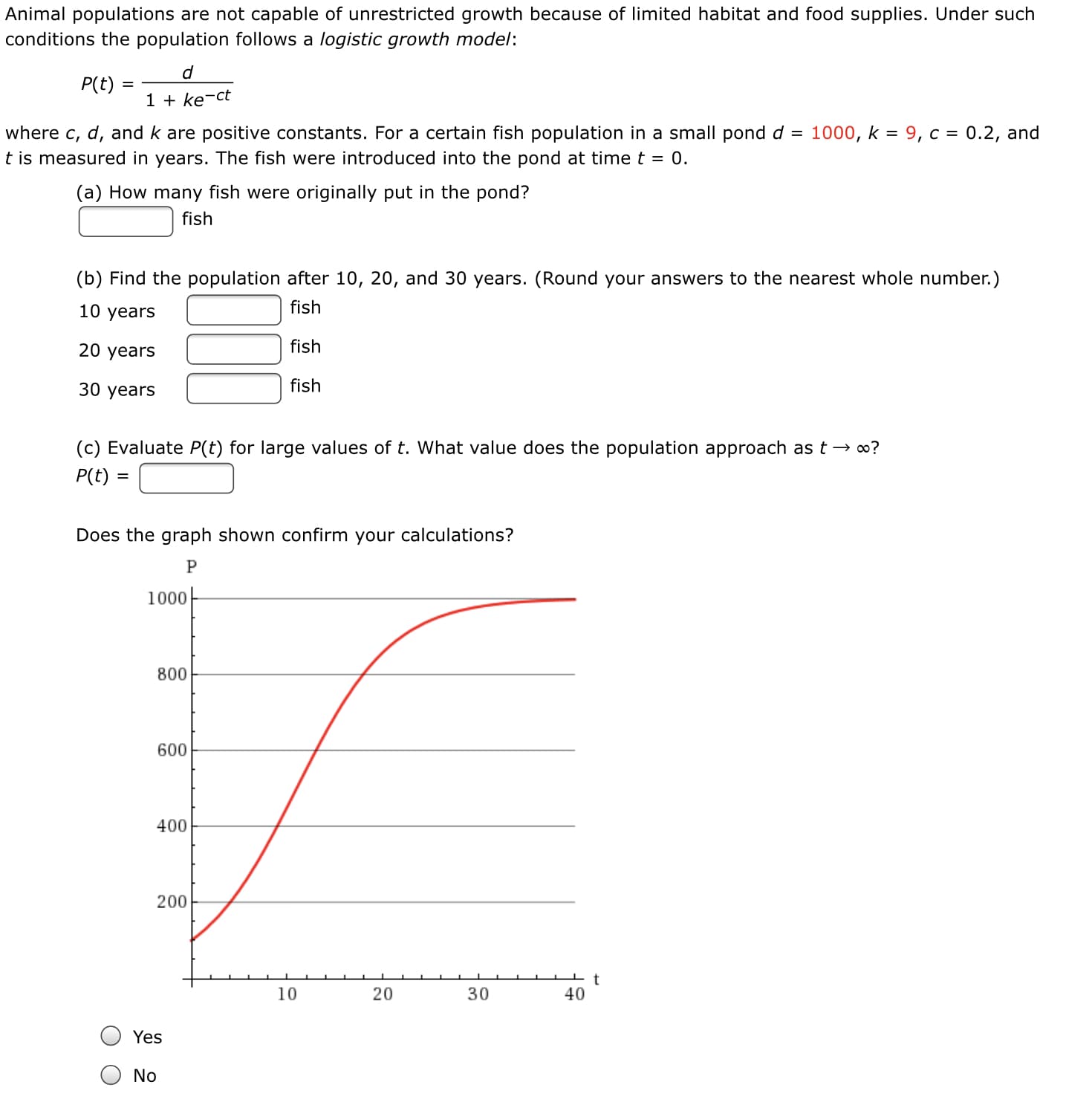Animal populations are not capable of unrestricted growth because of limited habitat and food supplies. Under such conditions the population follows a logistic growth model: d P(t) 1 + ke-ct where c, d, and k are positive constants. For a certain fish population in a small pond d = 1000, k = 9, c = 0.2, and is measured in years. The fish were introduced into the pond at time t = 0. (a) How many fish were originally put in the pond? fish (b) Find the population after 10, 20, and 30 years. (Round your answers to the nearest whole number.) 10 years fish 20 years fish 30 years fish (c) Evaluate P(t) for large values of t. What value does the population approach ast→ o? P(t) = Does the graph shown confirm your calculations? P 1000 800 600 400 200 10 30 40 Yes No 20 O O
Animal populations are not capable of unrestricted growth because of limited habitat and food supplies. Under such conditions the population follows a logistic growth model: d P(t) 1 + ke-ct where c, d, and k are positive constants. For a certain fish population in a small pond d = 1000, k = 9, c = 0.2, and is measured in years. The fish were introduced into the pond at time t = 0. (a) How many fish were originally put in the pond? fish (b) Find the population after 10, 20, and 30 years. (Round your answers to the nearest whole number.) 10 years fish 20 years fish 30 years fish (c) Evaluate P(t) for large values of t. What value does the population approach ast→ o? P(t) = Does the graph shown confirm your calculations? P 1000 800 600 400 200 10 30 40 Yes No 20 O O
Algebra & Trigonometry with Analytic Geometry
13th Edition
ISBN:9781133382119
Author:Swokowski
Publisher:Swokowski
Chapter5: Inverse, Exponential, And Logarithmic Functions
Section: Chapter Questions
Problem 18T
Related questions
Question

Transcribed Image Text:Animal populations are not capable of unrestricted growth because of limited habitat and food supplies. Under such
conditions the population follows a logistic growth model:
d
P(t)
1 + ke-ct
where c, d, and k are positive constants. For a certain fish population in a small pond d = 1000, k = 9, c = 0.2, and
is measured in years. The fish were introduced into the pond at time t = 0.
(a) How many fish were originally put in the pond?
fish
(b) Find the population after 10, 20, and 30 years. (Round your answers to the nearest whole number.)
10 years
fish
20 years
fish
30 years
fish
(c) Evaluate P(t) for large values of t. What value does the population approach ast→ o?
P(t) =
Does the graph shown confirm your calculations?
P
1000
800
600
400
200
10
30
40
Yes
No
20
O O
Expert Solution
This question has been solved!
Explore an expertly crafted, step-by-step solution for a thorough understanding of key concepts.
This is a popular solution!
Trending now
This is a popular solution!
Step by step
Solved in 5 steps with 5 images

Knowledge Booster
Learn more about
Need a deep-dive on the concept behind this application? Look no further. Learn more about this topic, calculus and related others by exploring similar questions and additional content below.Recommended textbooks for you

Algebra & Trigonometry with Analytic Geometry
Algebra
ISBN:
9781133382119
Author:
Swokowski
Publisher:
Cengage


Algebra & Trigonometry with Analytic Geometry
Algebra
ISBN:
9781133382119
Author:
Swokowski
Publisher:
Cengage
